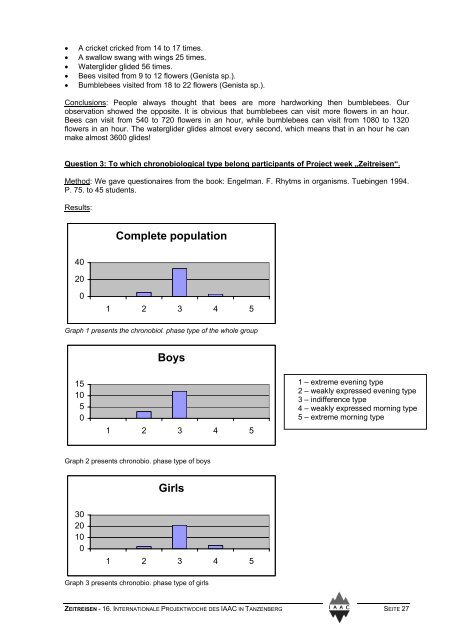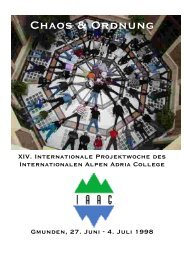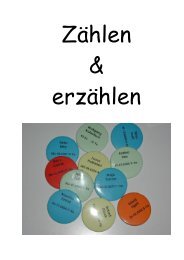ZEITREISEN - IAAC
ZEITREISEN - IAAC
ZEITREISEN - IAAC
Erfolgreiche ePaper selbst erstellen
Machen Sie aus Ihren PDF Publikationen ein blätterbares Flipbook mit unserer einzigartigen Google optimierten e-Paper Software.
• A cricket cricked from 14 to 17 times.<br />
• A swallow swang with wings 25 times.<br />
• Waterglider glided 56 times.<br />
• Bees visited from 9 to 12 flowers (Genista sp.).<br />
• Bumblebees visited from 18 to 22 flowers (Genista sp.).<br />
Conclusions: People always thought that bees are more hardworking then bumblebees. Our<br />
observation showed the opposite. It is obvious that bumblebees can visit more flowers in an hour.<br />
Bees can visit from 540 to 720 flowers in an hour, while bumblebees can visit from 1080 to 1320<br />
flowers in an hour. The waterglider glides almost every second, which means that in an hour he can<br />
make almost 3600 glides!<br />
Question 3: To which chronobiological type belong participants of Project week „Zeitreisen“.<br />
Method: We gave questionaires from the book: Engelman. F. Rhytms in organisms. Tuebingen 1994.<br />
P. 75. to 45 students.<br />
Results:<br />
Complete population<br />
40<br />
20<br />
0<br />
1 2 3 4 5<br />
Graph 1 presents the chronobiol. phase type of the whole group<br />
Boys<br />
15<br />
10<br />
5<br />
0<br />
1 2 3 4 5<br />
1 – extreme evening type<br />
2 – weakly expressed evening type<br />
3 – indifference type<br />
4 – weakly expressed morning type<br />
5 – extreme morning type<br />
Graph 2 presents chronobio. phase type of boys<br />
Girls<br />
30<br />
20<br />
10<br />
0<br />
1 2 3 4 5<br />
Graph 3 presents chronobio. phase type of girls<br />
<strong>ZEITREISEN</strong> - 16. INTERNATIONALE PROJEKTWOCHE DES <strong>IAAC</strong> IN TANZENBERG SEITE 27





